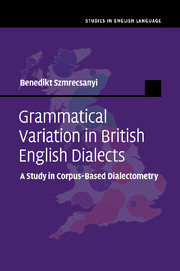Book contents
- Frontmatter
- Contents
- List of figures
- List of maps
- List of tables
- Preface and acknowledgments
- 1 Introduction
- 2 Data and methods
- 3 The feature catalogue
- 4 Surveying the forest: on aggregate morphosyntactic distances and similarities
- 5 Is morphosyntactic variability gradient? Exploring dialect continua
- 6 Classification: the dialect area scenario
- 7 Back to the features
- 8 Summary and discussion
- 9 Outlook and concluding remarks
- Appendices
- References
- Index
5 - Is morphosyntactic variability gradient? Exploring dialect continua
Published online by Cambridge University Press: 05 December 2012
- Frontmatter
- Contents
- List of figures
- List of maps
- List of tables
- Preface and acknowledgments
- 1 Introduction
- 2 Data and methods
- 3 The feature catalogue
- 4 Surveying the forest: on aggregate morphosyntactic distances and similarities
- 5 Is morphosyntactic variability gradient? Exploring dialect continua
- 6 Classification: the dialect area scenario
- 7 Back to the features
- 8 Summary and discussion
- 9 Outlook and concluding remarks
- Appendices
- References
- Index
Summary
We will now begin to push deeper into the geographic structure of linguistic variability in British English dialects. The matter that will concern us in this chapter is the extent to which the morphosyntactic dialect landscape in Great Britain can be thought of as being a dialect continuum – in other words, is linguistic distance proportional to geographic distance, such that dialect transitions are smooth as opposed to abrupt? Section 5.1 reviews the literature on dialect continua. Section 5.2 approaches the issue cartographically. Section 5.3 utilizes correlation analysis and regression techniques to quantify the extent to which linguistic distance is proportional to geographic distance. Section 5.4 is a chapter summary.
On dialect continua
There are two principal ways to think about dialect geographies (see Heeringa and Nerbonne 2001): the DIALECT AREA SCENARIO (an exploration of which is reserved for the following chapter), and the DIALECT CONTINUUM SCENARIO. Succinctly put, the dialect area scenario seeks to partition a given dialect landscape into internally homogeneous but mutually heterogeneous dialect areas. By contrast, the dialect continuum scenario posits that there are no sharp boundaries between dialects. Instead, linguistic distance is supposed to be directly proportional to geographic distance. In their extreme manifestations, the two scenarios are incompatible, for either we find sharp dialect boundaries, or we don't. Yet reality actually comes in shades of gray, and the present study operates on the assumption that the way in which geographic space conditions dialect variability has a continuum-like structure itself.
- Type
- Chapter
- Information
- Grammatical Variation in British English DialectsA Study in Corpus-Based Dialectometry, pp. 89 - 110Publisher: Cambridge University PressPrint publication year: 2012

